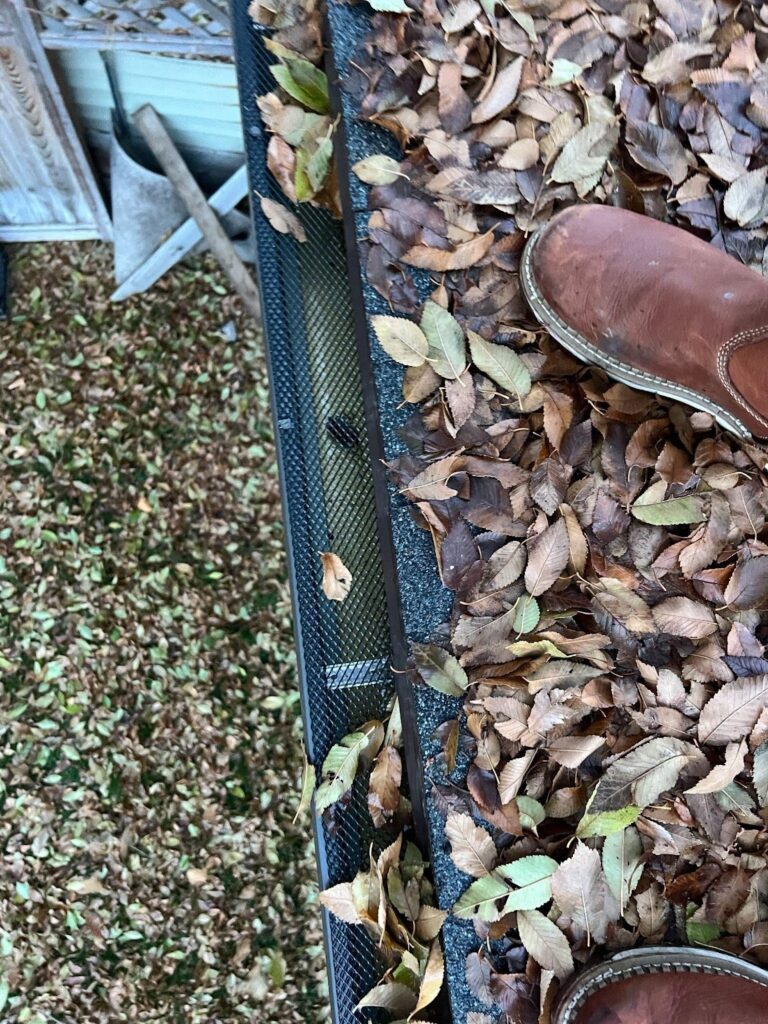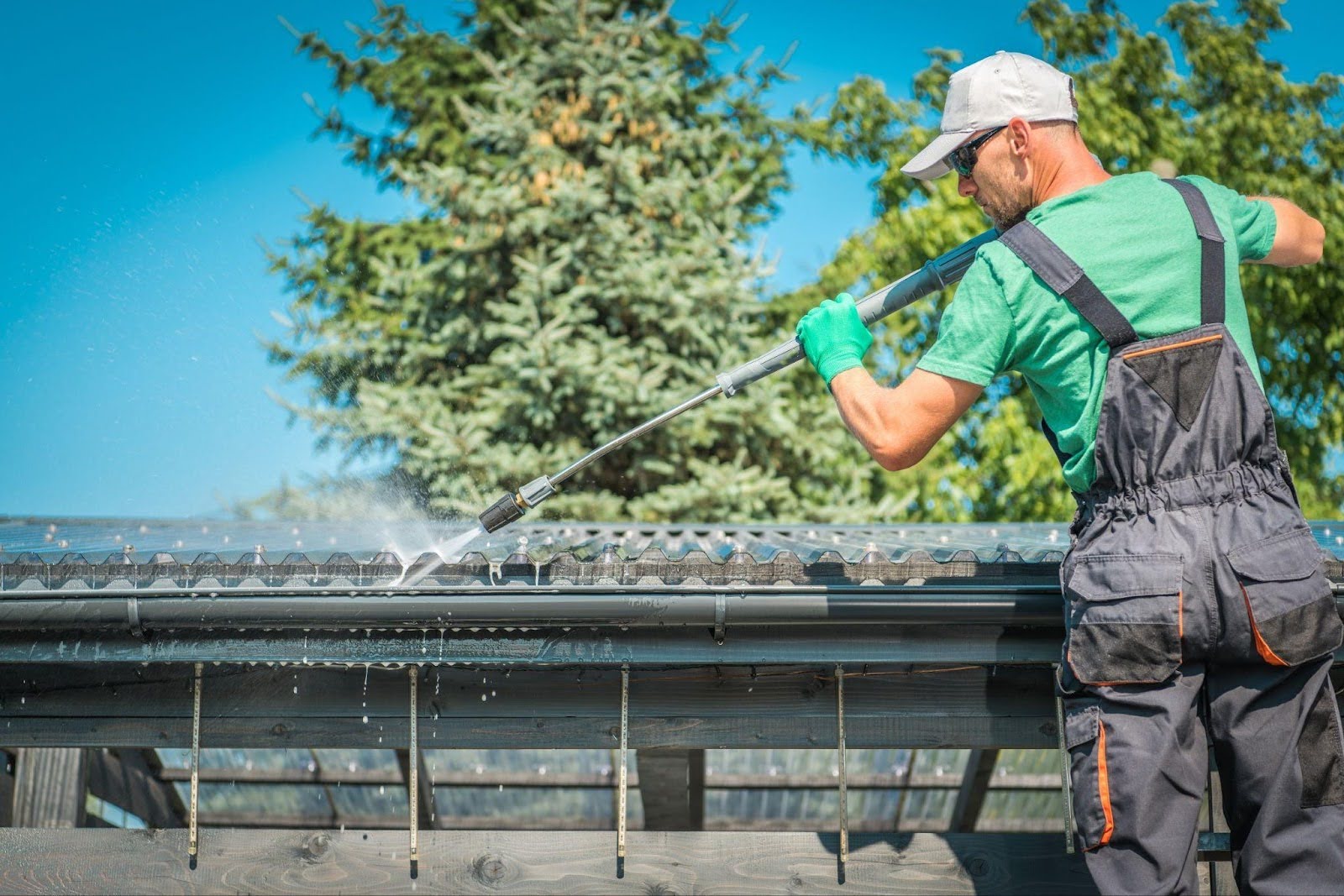Durable gutter guards are a great way to reduce gutter cleaning, but your rain gutters still require occasional attention to function optimally. Dirt, leaves, twigs, and roof debris may still collect on top or underneath, leading to clogs and overflows over time.
Your gutters require regular maintenance to ensure water flows smoothly and protects your home from damage. This guide will walk you through how often to clean them, what to look for, and how to tell when it’s time for professional help.
Why do gutter guard maintenance?
While the design of mesh guards is to keep out leaves and debris, they’re not a 100% hands-off solution. Over time, fine particles such as pollen, dust, and roof grit settle on top, and if left alone, they form a barrier that blocks water from entering the gutter.
Clogged or neglected rain gutters may lead to water backing up under your shingles, overflowing near your foundation, or attracting pests like birds and insects. In the winter, trapped debris also contributes to the formation of ice dams, which can cause long-term roof damage.
Even lightweight gutter guards and other low-maintenance systems require regular inspections to ensure they’re performing their intended function. Catching issues early helps you avoid expensive repairs and extend the life of your durable gutter guards and entire gutter system.

How often should you clean your gutter guards?
Most homeowners should clean their gutter guards at least twice a year — once in the spring and again in the fall. These seasons bring the most debris, from seed pods and blossoms in the spring to falling leaves and dust in the autumn. If your home is surrounded by trees or exposed to frequent storms, you may need to inspect them more frequently.
Homes with mesh gutter guards or other fine-screen styles are generally better at filtering small particles, but they’re still prone to buildup on top. Even the most durable guards become less effective when covered with too much debris. Inspecting your system every few months is the best way to prevent clogs before they start.
If you have any kind of lightweight gutter guard, you’ll want to keep an eye out for sagging, shifting, or signs of trapped moisture. A quick look after every major storm goes a long way in preserving your gutter system’s performance.
Tools you’ll need for cleaning
Having the right tools on hand makes the job safer, faster, and more effective. Whether you’re clearing seasonal buildup or doing a full inspection, here’s what we recommend:
1. Sturdy ladder
Choose a ladder that extends well past your roofline and sits securely on level ground. Use a stabilizer if possible, especially on uneven surfaces or when working alone.
2. Work gloves
Debris in your gutters can include sharp twigs, roofing granules, and biting insects. A durable pair of gloves will help protect your hands during the cleanout process.
3. Garden hose with a spray nozzle
A garden hose is great for rinsing off the tops of mesh gutter guards or flushing out any remaining debris inside the gutters. A nozzle with a focused spray helps push clogs through to eliminate any backups.
4. Soft brush or small hand scoop
Use these to remove leaves and grime that have collected on the guards. A plastic scoop is ideal for lifting debris without scratching the guard surface.
5. Bucket or tarp
Keep things tidy by collecting debris as you work. A bucket with a hook can hang from the ladder, while a tarp laid below will catch anything that falls.
6. Screwdriver or drill (optional)
If your lightweight gutter guards have fasteners holding them in place, you may need tools to remove and reattach them for a more thorough clean.
7. Flashlight
For shaded areas or checking tight corners, a flashlight helps spot trapped debris, pests, or signs of water damage.
By having the right equipment ready, you’ll save time and reduce the chance of missing potential issues, especially in hard-to-reach areas.

Step-by-step guide to cleaning gutter guards
1. Gather the right tools
Start with the basics: a sturdy ladder, work gloves, a soft-bristle brush or hand scoop, a bucket, and a garden hose. If your guards are removable, have a screwdriver or drill handy as well.
2. Put safety first
Always make sure your ladder is stable and placed on level ground. If possible, use a ladder stabilizer or have someone spot you while you work. Never attempt to clean your gutters during strong winds or adverse weather conditions.
3. Remove visible debris
Carefully brush or scoop off leaves, twigs, and roof grit resting on top of the guards. If too much gets piled on, it will also back up your gutters.
4. Inspect the guards and gutters
Look closely for any signs of damage or buildup underneath the guard system. Check for rust, loose fasteners, or sagging sections. Even durable gutter guards wear down over time if exposed to heavy storms or extreme temperatures.
5. Rinse the system
Use your garden hose to flush water through the gutters. Make sure everything is flowing properly toward the downspout. This step helps wash out smaller particles that may have slipped through the guards.
6. Re-secure or replace as needed
If any guards have shifted or detached, reattach them securely. Cracked or warped pieces may need replacement. If the system is too damaged or you’re unsure what’s causing a clog, consider calling in a professional.
Signs it’s time for professional help
Even with regular upkeep, a hose and ladder won’t always be the solution. If your gutters are still overflowing in a light rain, that’s a red flag. The same goes for water pooling near your foundation or visible signs of rust or mold along your fascia. If the pooling water gets bad enough, it may cause water damage to your basement.
Damaged or aging mesh gutter guards may start to warp, tear, or separate from the gutter. If your system is a few years old, it may no longer be able to withstand heavy debris or ice buildup. When guards no longer sit flush or start letting in pine needles, it’s time for a replacement.
It’s smart to bring in a professional if you’re uncomfortable working at heights or simply want to ensure your durable gutter guards are performing as expected. A trained technician will inspect the entire gutter system, reseal weak spots, and replace failing sections before they cause serious water damage.

Keep your gutter guards working year-round
Like any part of your home’s exterior, gutter guards need occasional care to stay effective — especially through Utah’s four distinct seasons. Spring pollen, summer dust, autumn leaves, and winter ice all impact your gutter system in different ways. Regular inspections and quick cleanups go a long way in preventing major problems.
Even the most durable gutter guards get overwhelmed if too much debris falls on top. By staying on top of maintenance, you’ll extend the life of your system and avoid unnecessary repairs. If you’ve chosen mesh gutter guards or other fine-screen styles, brushing off the surface every few months keeps water flowing freely.
Consider marking your calendar to check your lightweight gutter guards in early spring and late fall, or right after a major storm. If you don’t have time to handle it yourself, or you’d rather not work on a ladder, a professional gutter cleaning service can help keep things running smoothly.
If you know a large storm with heavy rain is coming, Better Homes and Gardens suggests multiple steps to prepare your home and yard before it hits, including cleaning out your rain gutters.
Call Wasatch Rain Gutters for debris guard maintenance
Whether you’ve installed mesh, lightweight gutter guards, or a heavy-duty option, regular maintenance makes all the difference. At Wasatch Rain Gutters, we help homeowners keep their systems in top shape with professional inspections, seasonal cleanouts, and long-term repair solutions.
If you’re seeing water overflow, clogged guards, or signs of damage, we’re ready to help. Our team understands how Utah’s weather affects every part of your gutter system, and we’ll make sure your durable guards continue to do their job for years to come.Call today or request a quote online to schedule your next gutter guard checkup. Clean, working gutters are one of your home’s most important defenses.

